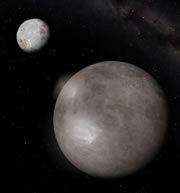This dramatic conclusion was made by Jason Cook at Arizona State University, Tempe, who looked at Charon's near-infrared spectrum using telescopes at the Gemini Observatory at Mauna Kea, Hawaii. Cook found traces of both crystalline water ice and ammonia, he reports in Astrophysical Journal1.
Cook says that icy crystals can only exist on Charon if they are regularly deposited there. Crystalline ice cannot exist for long on the surface because it is bombarded with ultra-violet radiation from the Sun and charged particles, and these smooth out the crystals, he says. This is where the volcanoes come in.

|
| ©Software Bisque/ Mark C. Petersen, Loch Ness Productions / DigitalSky 2, Sky-Skan, Inc. |
| An artist's impression of volcanic snow. |
Cook speculates that liquid water deep within Charon's core is mixed with ammonia, which acts like antifreeze and lowers the freezing point. Volcanoes could then belch out this water, which would immediately freeze and snow back down onto the surface of Charon as crystals of ice and the ammonia hydrates that Cook detects in his spectra.
"We looked at several processes; none worked except cryovolcanism," says Cook.
Kicked up
It's great to pin down which substances are on Charon's surface, says William McKinnon, an expert on icy satellites from Washington University, St Louis. But he thinks that there could be alternative explanations for the ice, other than 'cryovolcanoes'.
He suggests that the core may stay liquid not because of the presence of ammonia (it is unlikely that Charon is rich enough in ammonia for that, he says), but by a porous outer layer of icy rock that insulates the interior from the chilly exterior.
And Charon's surface is churned up by asteroid impacts as a matter of course and this could be enough to kick up crystals on the surface, he says.
The New Horizons mission to the Kuiper belt - a ring of comets in the outer reaches of the Solar System beyond Pluto - should solve the conundrum once and for all. The mission, which will arrive at the Kuiper belt in 2015, will get high-quality data about the composition of Pluto and its satellites.
"In eight years we'll see one way or the other," says McKinnon, "but I don't expect to see geysers."



Reader Comments
to our Newsletter